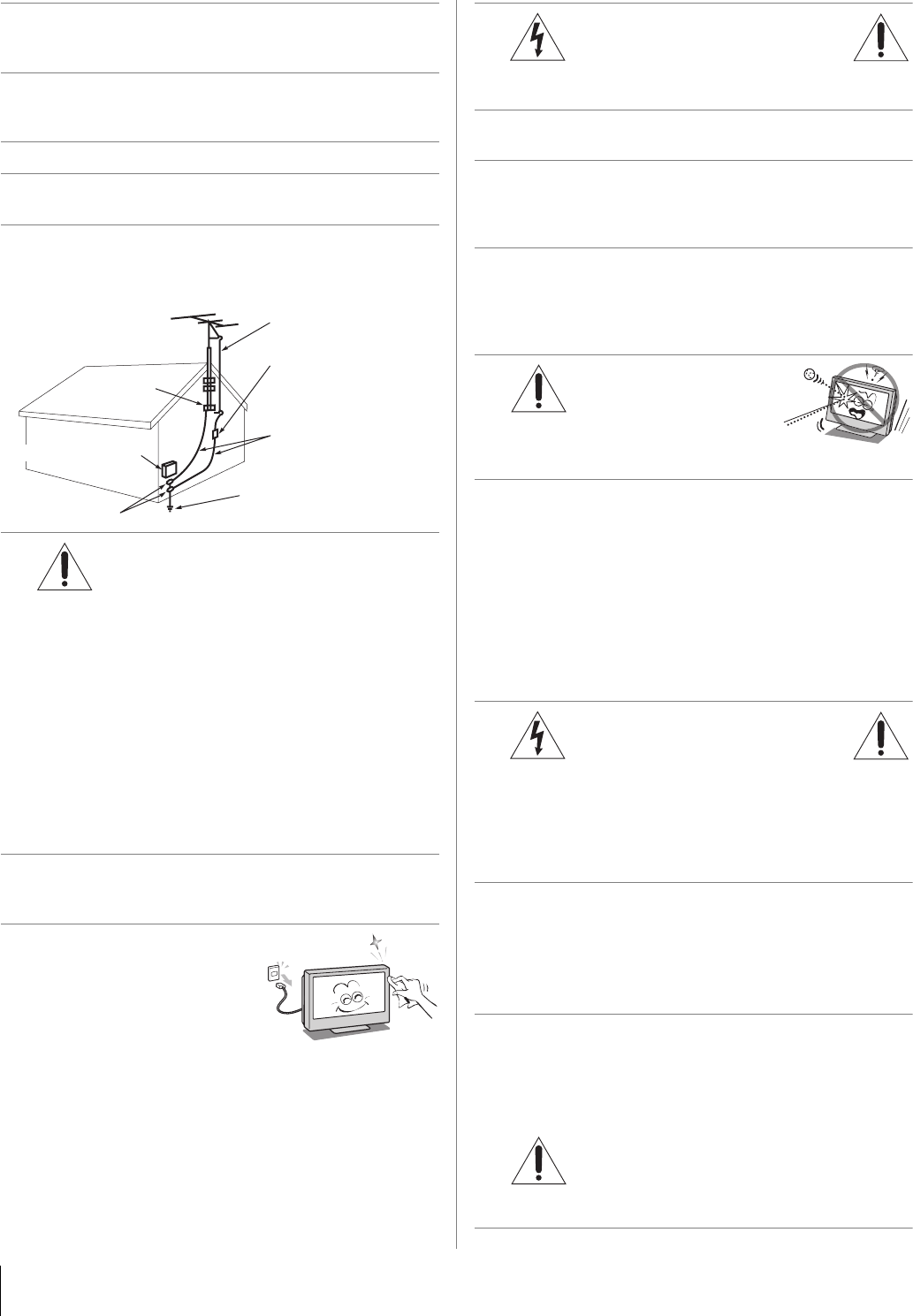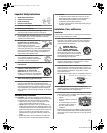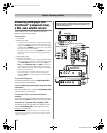
4
HLC56 (E/F) Web 213:276
22) Always place the back of the monitor at least one (1) inch
away from any vertical surface (such as a wall) to allow
proper ventilation.
23) Never allow anything to rest on or roll over the power cord,
and never place the monitor where the power cord is
subject to wear or abuse.
24) Never overload wall outlets and extension cords.
25) Always operate this equipment from a 120 VAC, 60 Hz
power source only.
26) Always make sure the antenna system is properly
grounded to provide adequate protection against voltage
surges and built-up static charges (see Section 810 of the
National Electric Code).
27)
• Use extreme care to make sure you are never in a
position where your body (or any item you are in contact
with, such as a ladder or screwdriver) can accidentally
touch overhead power lines. Never locate the antenna
near overhead power lines or other electrical circuits.
• Never attempt to install any of the following during
lightning activity: a) an antenna system; or b) cables,
wires, or any home theater component connected to an
antenna or phone system.
Care
For better performance and safer operation of your TOSHIBA
monitor, follow these recommendations and precautions:
28) If you use the monitor in a room whose temperature is
32 ºF (0 ºC) or below, the picture brightness may vary until
the LCD warms up. This is not a sign of malfunction.
29) Always unplug the monitor
before cleaning. Gently wipe the
display panel surface (the
monitor screen) using a dry, soft
cloth only (cotton, flannel, etc.).
A hard cloth may damage the
surface of the panel. Avoid
contact with alcohol, thinner, benzene, acidic or alkaline
solvent cleaners, abrasive cleaners, or chemical cloths,
which may damage the surface. Never spray volatile
compounds such as insecticide on the cabinet. Such
products may damage or discolor the cabinet.
30)
Never spill liquids or push objects of any kind into the
monitor cabinet slots.
31) While it is thundering, do not touch the connecting cables
or apparatus.
32) For added protection of your monitor from lightning and
power surges, always unplug the power cord and
disconnect the antenna from the monitor if you leave the
monitor unattended or unused for long periods of time.
33) During normal use, the monitor may make occasional
snapping or popping sounds. This is normal, especially
when the unit is being turned on or off. If these sounds
become frequent or continuous, unplug the power cord
and contact a Toshiba Authorized Service Center.
34)
WARNING: RISK OF
SERIOUS PERSONAL
INJURY OR EQUIPMENT
DAMAGE!
Never strike the screen with a sharp
or heavy object.
35) • The LCD screen of this product can be damaged by
ultraviolet radiation from the sun. When selecting a
location for the monitor, avoid locations where the
screen may be exposed to direct sunlight, such as in
front of a window.
• Never touch, press, or place anything on the LCD
screen. These actions will damage the LCD screen. If
you need to clean the LCD screen, follow the
instructions in item 29 on this page.
Service
36)
Never attempt to service the monitor yourself. Opening
and removing the covers may expose you to dangerous
voltage or other hazards. Failure to follow this WARNING
may result in death or serious injury. Refer all servicing not
specified in this manual to a Toshiba Authorized Service
Center.
37) If you have the monitor serviced:
• Ask the service technician to use only replacement
parts specified by the manufacturer.
• Upon completion of service, ask the service technician
to perform routine safety checks to determine that the
monitor is in safe operating condition.
38) The cold cathode fluorescent lamp in the LCD panel
contains a small amount of mercury.
When the monitor reaches the end of its useful life,
dispose of the used monitor by the approved method for
your area, or ask a qualified service technician to properly
dispose of the monitor.
Note: The lamp unit contains mercury, the
disposal of which may be regulated due to
environmental considerations. For disposal or
recycling information, contact your local authorities or the
Electronics Industries Alliance (www.eiae.org).
Ground clamp
Antenna discharge unit
(NEC Section 810-20)
Grounding conductors
(NEC Section 810-21)
Power service grounding
electrode system (NEC Art 250 Part-H)
Ground clamps
Antenna lead-in wire
Electric service equipment
DANGER: RISK OF SERIOUS
PERSONAL INJURY OR DEATH!
WARNING:
RISK OF ELECTRIC SHOCK!
WARNING:
RISK OF ELECTRIC SHOCK!
263237HLC56_EN.book Page 4 Monday, June 5, 2006 3:46 PM


















